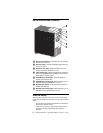
1
General checkout
The server diagnostic programs are stored in upgradable
read-only memory (ROM) on the system board. These pro-
grams are the primary method of testing the major compo-
nents of the server: the system board, Ethernet controller,
video controller, RAM, keyboard, mouse (pointing device),
diskette drive, serial ports, hard drives, and parallel port.
You can also use them to test some external devices. See
“Diagnostic programs and error messages” on page 10.
Also, if you cannot determine whether a problem is caused
by the hardware or by the software, you can run the diag-
nostic programs to confirm that the hardware is working
properly.
When you run the diagnostic programs, a single problem
might cause several error messages. When this occurs,
work to correct the cause of the first error message. After
the cause of the first error message is corrected, the other
error messages might not occur the next time you run the
test.
A failed system might be part of a shared DASD cluster (two
or more systems sharing the same external storage
device(s)). Prior to running diagnostics, verify that the failing
system is not part of a shared DASD cluster.
A system might be part of a cluster if:
• The customer identifies the system as part of a cluster.
• One or more external storage units are attached to the
system and at least one of the attached storage units is
additionally attached to another system or unidentifi-
able source.
• One or more systems are located near the failing sys-
tem.
If the failing system is suspected to be part of a shared
DASD cluster, all diagnostic tests can be run except diag-
nostic tests which test the storage unit (DASD residing in the
storage unit) or the storage adapter attached to the storage
unit.
Notes:
1. For systems that are part of a shared DASD cluster, run
one test at a time in looped mode. Do not run all tests
in looped mode, as this could enable the DASD diag-
nostic tests.
2. If multiple error codes are displayed, diagnose the first
error code displayed.
3. If the computer hangs with a POST error, go to the
“Symptom-to-FRU index” on page 129.
4. If the computer hangs and no error is displayed, go to
“Undetermined problems” on page 147.
5. Power supply problems, see “Symptom-to-FRU index”
on page 129.
6. Safety information, see “Safety information” on page
155.


















